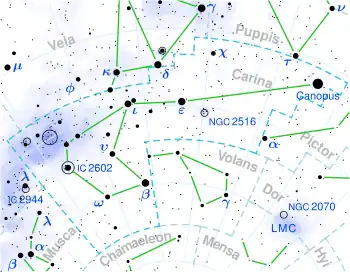V602 Carinae
V602 Carinae (V602 Car, HD 97671) is a red supergiant and variable star of spectral type of M3 in the constellation Carina. It is one of largest known stars.
 Location of V602 Car | |
| Observation data Epoch J2000.0 Equinox J2000.0 (ICRS) | |
|---|---|
| Constellation | Carina |
| Right ascension | 11h 13m 29.9740s[1] |
| Declination | −60° 05′ 28.838″[1] |
| Apparent magnitude (V) | 8.39[2] (7.6 - 9.1[3]) |
| Characteristics | |
| Spectral type | M3 Ia-Iab[4] |
| U−B color index | +2.59[2] |
| B−V color index | +2.52[2] |
| Variable type | SRc[3] |
| Astrometry | |
| Proper motion (μ) | RA: −5.425[5] mas/yr Dec.: 2.183[5] mas/yr |
| Parallax (π) | 0.4366 ± 0.0698 mas[5] |
| Distance | 1,190[6] pc |
| Absolute magnitude (MV) | –4.83 (variable)[6] |
| Details | |
| Mass | 17.7[7] M☉ |
| Radius | 932[8] R☉ |
| Luminosity | 125,000 - 131,000[8] L☉ |
| Surface gravity (log g) | −0.3±0.16[9] cgs |
| Temperature | 3,550±170[8] K |
| Other designations | |
| Database references | |
| SIMBAD | data |
In 2005, V602 Car was calculated to have a bolometric luminosity below 110,000 L☉ and a radius around 860 R☉ based on the assumption of an effective temperature of 3,550 K.[10] A 2015 study derived a slightly higher bolometric luminosity of 138,000+66,000
−45,000 L☉ based on the measured flux and an assumed distance, and a larger radius of 1,050±165 R☉ based on the measured angular diameter and luminosity. An effective temperature of 3,432±280 K was then calculated from the luminosity and radius.[9] More recent measurements based on a Gaia Data Release 2 parallax of 0.4366±0.0698 mas gives a luminosity at 125,000–131,000 L☉ with a corresponding radius of 932 R☉ based on the same effective temperature derived in 2005.[8]
V602 Car has an estimated mass loss rate of 1.9×10−6 M☉ per year.[2] An excess of emission at long wavelengths from this star, as well as a small amount of silicate emission, suggests that it may be enclosed by an extensive cloud of dust.[11]

V602 Car is a semiregular variable star with a maximum brightness range of magnitude 7.6 - 9.1[12] and a period of 635[12] or 672[3] days. Despite the large amplitude of variation, it was only named as a variable star in 2006.[3][12]
See also
References
- Hog, E.; Kuzmin, A.; Bastian, U.; Fabricius, C.; Kuimov, K.; Lindegren, L.; Makarov, V. V.; Roeser, S. (1998). "The TYCHO Reference Catalogue". Astronomy and Astrophysics. 335: L65. Bibcode:1998A&A...335L..65H.
- Mauron, N.; Josselin, E. (February 2011), "The mass-loss rates of red supergiants and the de Jager prescription", Astronomy and Astrophysics, 526: A156, arXiv:1010.5369, Bibcode:2011A&A...526A.156M, doi:10.1051/0004-6361/201013993, S2CID 119276502.
- Samus, N. N.; Durlevich, O. V.; et al. (2009). "VizieR Online Data Catalog: General Catalogue of Variable Stars (Samus+ 2007-2013)". VizieR On-line Data Catalog: B/GCVS. Originally Published in: 2009yCat....102025S. 1. Bibcode:2009yCat....102025S.
- Keenan, Philip C.; McNeil, Raymond C. (1989). "The Perkins catalog of revised MK types for the cooler stars". Astrophysical Journal Supplement Series. 71: 245. Bibcode:1989ApJS...71..245K. doi:10.1086/191373.
- Brown, A. G. A.; et al. (Gaia collaboration) (August 2018). "Gaia Data Release 2: Summary of the contents and survey properties". Astronomy & Astrophysics. 616. A1. arXiv:1804.09365. Bibcode:2018A&A...616A...1G. doi:10.1051/0004-6361/201833051. Gaia DR2 record for this source at VizieR.
- Melnik, A. M.; Dambis, A. K. (2020). "Distance scale for high-luminosity stars in OB associations and in field with Gaia DR2. Spurious systematic motions". Astrophysics and Space Science. 365 (7). arXiv:2006.14649. doi:10.1007/s10509-020-03827-0. S2CID 220128144.
- Fadeyev, Yu. A. (2012). "Nonlinear pulsations of red supergiants". Astronomy Letters. 38 (4): 260–270. arXiv:1112.2365. Bibcode:2012AstL...38..260F. doi:10.1134/S1063773712040032. S2CID 118612597.
- Messineo, M.; Brown, A. G. A. (2019). "A Catalog of Known Galactic K-M Stars of Class I Candidate Red Supergiants in Gaia DR2". The Astronomical Journal. 158 (1): 20. arXiv:1905.03744. Bibcode:2019AJ....158...20M. doi:10.3847/1538-3881/ab1cbd. S2CID 148571616.
- Arroyo-Torres, B.; Wittkowski, M.; Chiavassa, A.; Scholz, M.; Freytag, B.; Marcaide, J. M.; Hauschildt, P. H.; Wood, P. R.; Abellan, F. J. (2015). "What causes the large extensions of red supergiant atmospheres?. Comparisons of interferometric observations with 1D hydrostatic, 3D convection, and 1D pulsating model atmospheres". Astronomy & Astrophysics. 575: A50. arXiv:1501.01560. Bibcode:2015A&A...575A..50A. doi:10.1051/0004-6361/201425212. S2CID 29210064.
- Levesque, Emily M.; Massey, Philip; Olsen, K. A. G.; Plez, Bertrand; Josselin, Eric; Maeder, Andre; Meynet, Georges (2005). "The Effective Temperature Scale of Galactic Red Supergiants: Cool, but Not as Cool as We Thought". The Astrophysical Journal. 628 (2): 973–985. arXiv:astro-ph/0504337. Bibcode:2005ApJ...628..973L. doi:10.1086/430901. S2CID 15109583.
- Humphreys, Roberta M.; Strecker, Donald W.; Ney, E. P. (February 1972), "Spectroscopic and Photometric Observations of M Supergiants in Carina", Astrophysical Journal, 172: 75, Bibcode:1972ApJ...172...75H, doi:10.1086/151329.
- Kazarovets, E. V.; Samus, N. N.; Durlevich, O. V.; Kireeva, N. N.; Pastukhova, E. N. (2006). "The 78th Name-List of Variable Stars". Information Bulletin on Variable Stars. 5721: 1. Bibcode:2006IBVS.5721....1K.